新人教版七年级下册英语知识点归纳总结
人教版初中英语七年级下册知识点总结
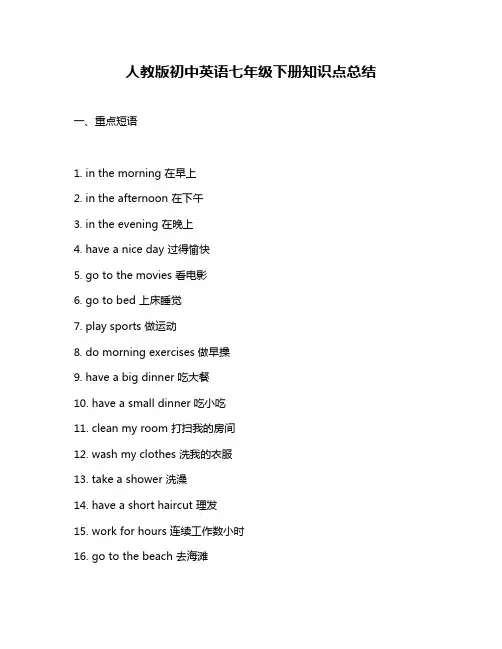
人教版初中英语七年级下册知识点总结一、重点短语1. in the morning 在早上2. in the afternoon 在下午3. in the evening 在晚上4. have a nice day 过得愉快5. go to the movies 看电影6. go to bed 上床睡觉7. play sports 做运动8. do morning exercises 做早操9. have a big dinner 吃大餐10. have a small dinner 吃小吃11. clean my room 打扫我的房间12. wash my clothes 洗我的衣服13. take a shower 洗澡14. have a short haircut 理发15. work for hours 连续工作数小时16. go to the beach 去海滩17. on the weekend 在周末18. listen to music 听音乐19. have a party 举办聚会20. watch TV 看电视21. play computer games 玩电脑游戏22. in the pool 在游泳池里23. go to the zoo 去动物园24. in the mountains 在山里25. have fun 玩得开心26. the great wall 长城27. many places of interest 名胜古迹28. be ready for 为……准备好29. stay healthy 保持健康30. how much 多少31. would you like 一些……吗?32. some noodles 一些面条33. order a pizza 定一个披萨饼34. make a phone order 电话订购35. would you like to do sth 你愿意做某事吗?36. want to do sth 想做某事37. would you like +名词你愿意要……吗?38. would you like +动词不定式你愿意……吗?39. choose some food 选择一些食物40. order the food 订购食物41. be careful 当心;小心42. not much 不多;少量的43. be ready to do sth 准备好做某事。
人教版七年级下册英语各单元知识点归纳
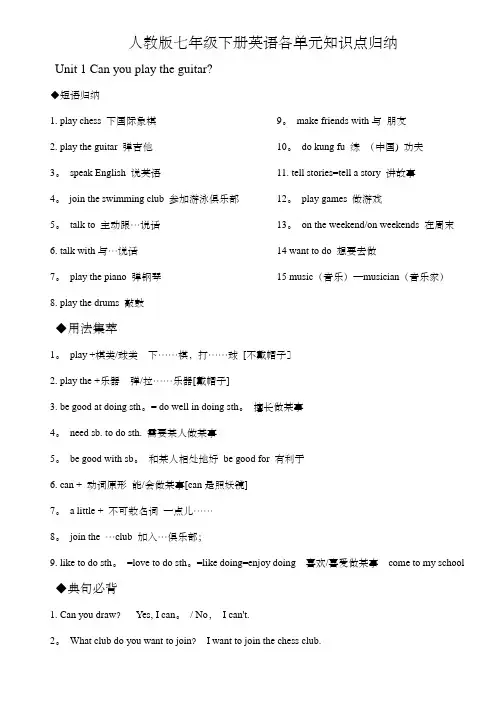
5。be good with sb。和某人相处地好be good for有利于
6. can +动词原形能/会做某事[can是照妖镜]
7。a little +不可数名词一点儿……
8。join the…club加入…俱乐部;
9. like to do sth。=love to do sth。=like doing=enjoy doing喜欢/喜爱做某事come to my school
6 No+doing或者No+名词,例如No swimming!No photos!
Unit 5 Why do you like pandas?
◆短语归纳
1. kind of = a little有几分,有点儿,修饰形容词,表示程度
14 want to do想要去做
15 music(音乐)—musician(音乐家)
◆用法集萃
1。play +棋类/球类下……棋,打……球[不戴帽子]
2. play the +乐器弹/拉……乐器[戴帽子]
3. be good at doing sth。= do well in doing sth。擅长做某事
6. It is + adj. + to do sth.做某事是….It是形式主语,不定式是真正的主语
7. Thanks for + n。/ doing感谢你(做)某事。He is like a father to me.【like】是介词,表示“像"8 What do you think of the movie?=How do you like the movie?你认为这部电影总么样?
人教版七年级英语下册总复习知识点考点总结归纳
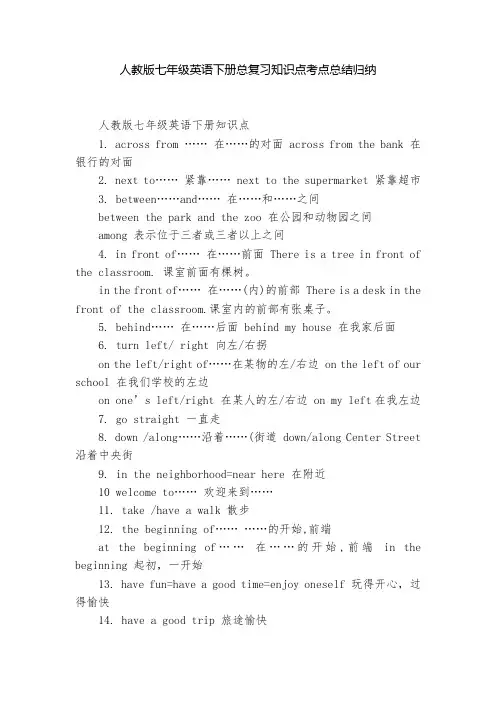
人教版七年级英语下册总复习知识点考点总结归纳人教版七年级英语下册知识点1. across from ……在……的对面 across from the bank 在银行的对面2. next to……紧靠…… next to the supermarket 紧靠超市3. between……and……在……和……之间between the park and the zoo 在公园和动物园之间among 表示位于三者或三者以上之间4. in front of……在……前面 There is a tree in front of the classroom. 课室前面有棵树。
in the front of……在……(内)的前部 There is a desk in the front of the classroom.课室内的前部有张桌子。
5. behind……在……后面 behind my house 在我家后面6. turn left/ right 向左/右拐on the left/right of……在某物的左/右边 on the left of our school 在我们学校的左边on one’s left/right 在某人的左/右边 on my left在我左边7. go straight 一直走8. down /along……沿着……(街道 down/along Center Street 沿着中央街9. in the neighborhood=near here 在附近10 welcome to……欢迎来到……11. take /have a walk 散步12. the beginning of…………的开始,前端at the beginning of……在……的开始,前端in the beginning 起初,一开始13. have fun=have a good time=enjoy oneself 玩得开心,过得愉快14. have a good trip 旅途愉快15. take a taxi 坐出租车16. 到达:get to +地方get here/ there/ home 到这/那/家 arrive in +大地方 I arrive in Beijing. arrive at +小地方I arrive at the bank. reach +地方17.go across 从物体表面横过 go across the street横过马路go through 从空间穿过 go through the forest穿过树林18.on + 街道的名称。
新人教版七年级下册英语各单元知识点总结
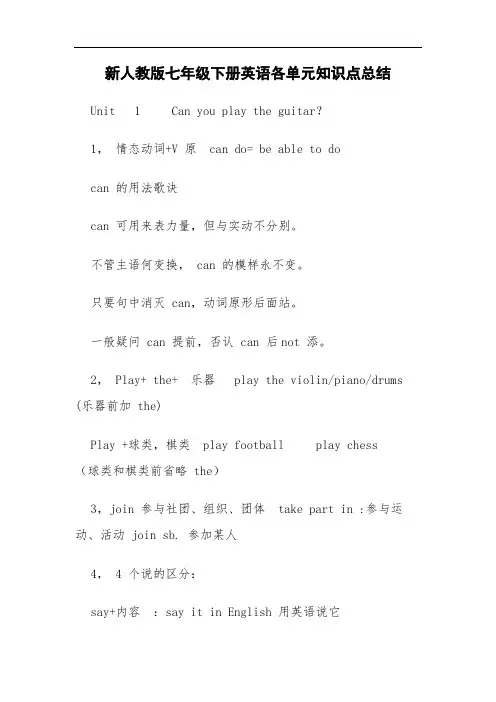
新人教版七年级下册英语各单元知识点总结Unit 1 Can you play the guitar?1,情态动词+V 原can do= be able to docan 的用法歌诀can 可用来表力量,但与实动不分别。
不管主语何变换, can 的模样永不变。
只要句中消灭 can,动词原形后面站。
一般疑问 can 提前,否认 can 后not 添。
2, Play+ the+ 乐器 play the violin/piano/drums (乐器前加 the)Play +球类,棋类play football play chess (球类和棋类前省略 the)3,join 参与社团、组织、团体take part in :参与运动、活动 join sb. 参加某人4, 4 个说的区分:say+内容:say it in English 用英语说它speak+语言: speak English 说英语talk 谈论 talk about sth. 谈论某事 talkwith/to sb 和某人交谈tell 告知,表达tell sb. (not)to do sth告知某人(不)去做某事(tell a story)tell stories/ jokes 讲故事/笑话5, want 的用法:想要(动词)(1) want to do sth.= would like to do sth 想要做某事(2) want (sb)to do sth.= would like +(sb)to do sth 想要做某事6, 4 个也的区分: too 确定句末(前面加逗号)either 否认句末(前面加逗号)also 句中,放在实意动词前, be 动词和情态动词之后as well 口语中(前面不加逗号)7, be good at =do well in+ V-ing/N. 擅长于(做)…… be good at playing soccer用法拓展:be good for 对…有益(be bad for 对…有害)be good to 对…友好(good 可用 friendly,nice,kind 替换)be good with 和…相处好=get on/ along well with8,特别疑问句的构成:疑问词+一般疑问句9, How/ what about+V-ing …怎么样?(表建议)What about playing basketball ? 10,感官动词(look, sound, taste, smell, feel)+adj/ like11.选择疑问句:答复不能直接用 Yes 或者 No,要从中选择一个答复Can you play the piano,,the drums,or the guitar? Ican play the drums.你会弹奏钢琴,敲鼓,或者弹吉他吗?我会打鼓12,students wanted for school show 学校演出招募学生(wanted 表示招募,含有被动意义)13,show sth to sb=show sb sth 给某人看某物 show me your book=show your book to me on show,意为“在展出”give sth to sb=give sb sth 给某人某物give me a pen =give a pen to me14,help sb (to)do sth 帮助某人做某事help sb with sth 帮助某人某事with sb’s help= with the help of sb 在某人的帮助下help oneself to 任凭享用15,be busy doing sth= be busy with sth 忙于做某事,be busy doing his homework= be busy with his homework 忙于他的家庭作业116,sb. need to do sth 某人需要做某事 need sb. to do sth 需要某人做某事17,be free= have time 有空的be busy 劳碌的18,make friends 交朋友 make friends with sb.与某人交朋友19,call sb at +电话号码给某人打---电话20,on the weekend= on weekends 在周末21,English-speaking students 说英语的学生(带有连词符,有形容词性质)22,do kung fu 表演功夫23,in, on 和at 在表达时间方面的区分①in+年、月、季节;泛指在上午,下午,晚上,如: inthe morning(afternoon, evening). in spring 在春季in September 在九月②on 指在某一天或某一天的上午,下午,晚上,具体到某一天、节日如: on Monday, on Sunday afternoon, on July 1, 1999 on New Year’s Day③at,一般表示点时间,如 at six o’clock, at three thirty.、习惯用法: at night, at noon,留意:在英语中,假设时间名词前用 this, last, next 等修饰时,像这样的表示,“在某时”的时间短语前,并不需要任何介词。
人教版七年级英语下册单元知识点总结(全册)
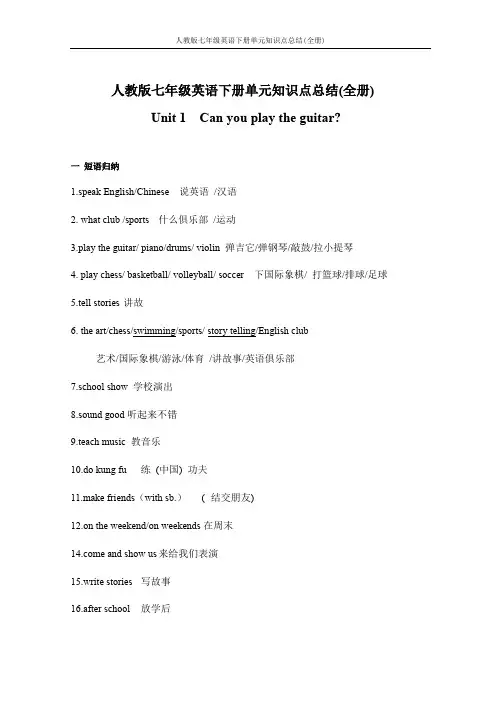
人教版七年级英语下册单元知识点总结(全册)Unit 1 Can you play the guitar?一短语归纳1.speak English/Chinese 说英语/汉语2. what club /sports什么俱乐部/运动3.play the guitar/ piano/drums/ violin 弹吉它/弹钢琴/敲鼓/拉小提琴4. play chess/ basketball/ volleyball/ soccer 下国际象棋/ 打篮球/排球/足球5.tell stories讲故6. the art/chess/swimming/sports/ story telling/English club艺术/国际象棋/游泳/体育/讲故事/英语俱乐部7.school show 学校演出8.sound good听起来不错9.teach music 教音乐10.do kung fu练(中国) 功夫11.make friends(with sb.)(结交朋友)12.on the weekend/on weekends在周末e and show us来给我们表演15.write stories写故事16.after school放学后17.English-speaking students说英语的学生18.play games 做游戏19.the Students’ Sports Center学生运动中心20.at the old people’s home在老人之家21.be in our school music festival 参加学校音乐节22.jion the music club加入音乐俱乐部二用法集萃1. play +棋类/球类下……棋,打……球2. play the +乐器弹/拉……乐器3. be good at doing sth.擅长做某事be good for.. 对… 有好处be good /kind to … 对… 友好4. be good with sb. 和某人相处地好; 善于应付(处理)…5. need(sb./sth.)to do… 需要(某人/某物)做….6. can + 动词原形能/会做某事7. a little + 不可数名词: 一点儿……9. like to do sth.或like doing sth. 喜欢做某事10.want to do…想做……11.What about…?…怎么样?(后面接Ving/代词/名词)12. talk用法: talk to/with sb. 跟某人说话talk about sth. 谈论某事tell 用法:tell sb sth. 告诉某人某事tell sb to do sth 告诉某人去做某事tell stories 讲故事say用法:say直接加说话的内容/itspeak用法:speak +语言13.help sb. with sth在某方面帮助某人= help sb.(to)do sth14.be free /busy有空/很忙15. call sb. at+号码拨打某人的……号码16. be in=join …成为…中的一员(P6)17.want …for the school show为学校表演招聘……三典句必背1. Can you draw? 你会画画吗?Yes, I can. / No, I can’t.是,我会。
新人教版七年级下册英语所有语法知识点全汇总
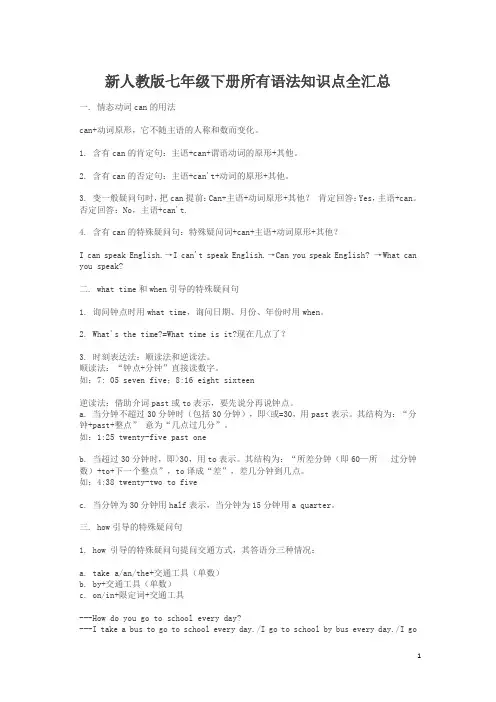
新人教版七年级下册所有语法知识点全汇总一. 情态动词can的用法can+动词原形,它不随主语的人称和数而变化。
1. 含有can的肯定句:主语+can+谓语动词的原形+其他。
2. 含有can的否定句:主语+can't+动词的原形+其他。
3. 变一般疑问句时,把can提前:Can+主语+动词原形+其他?肯定回答:Yes,主语+can。
否定回答:No,主语+can't.4. 含有can的特殊疑问句:特殊疑问词+can+主语+动词原形+其他?I can speak English.→I can't speak English.→Can you speak English? →What can you speak?二. what time和when引导的特殊疑问句1. 询问钟点时用what time,询问日期、月份、年份时用when。
2. What's the time?=What time is it?现在几点了?3. 时刻表达法:顺读法和逆读法。
顺读法:“钟点+分钟”直接读数字。
如:7: 05 seven five;8:16 eight sixteen逆读法:借助介词past或to表示,要先说分再说钟点。
a. 当分钟不超过30分钟时(包括30分钟),即<或=30,用past表示。
其结构为:“分钟+past+整点”意为“几点过几分”。
如:1:25 twenty-five past oneb. 当超过30分钟时,即>30,用to表示。
其结构为:“所差分钟(即60—所过分钟数)+to+下一个整点”,to译成“差”,差几分钟到几点。
如:4:38 twenty-two to fivec. 当分钟为30分钟用half表示,当分钟为15分钟用a quarter。
三. how引导的特殊疑问句1. how 引导的特殊疑问句提问交通方式,其答语分三种情况:a. take a/an/the+交通工具(单数)b. by+交通工具(单数)c. on/in+限定词+交通工具---How do you go to school every day?---I take a bus to go to school every day./I go to school by bus every day./I goto school on the bus every day.2. how far 用来提问距离,多远,其答语分为两种:(1)用长度单位表示:It is five kilometers.(2)用时间表示:It’s twenty minutes’walk.3. how long 用来提问时间,意为多久回答常用“for+段时”。
人教版英语七年级下册各单元重要语法内容
一、动词的一般现在时人教版英语七年级下册的重要语法内容之一为动词的一般现在时。
在学习动词的一般现在时时,学生需要掌握动词的三单特殊变化规则,即在第三人称单数时,动词需要在词尾加上-s或-es。
学生还需要学习动词的否定形式和疑问形式的构成方法,以及常见的一般现在时的时间状语如often, usually, always等的用法。
二、名词的单数和复数形式另一个重要的语法内容是名词的单数和复数形式。
学生需要了解名词单数和复数形式的规则,掌握常见的名词复数变化规则,如在词尾加上-s, -es, -ies等。
学生还要熟练掌握一些不规则名词的复数形式,如man-men, woman-women等。
三、形容词的比较级和最高级形容词的比较级和最高级也是七年级下册的重要语法内容之一。
学生需要学习形容词比较级的构成方法以及常见的比较级形式,如比较级+than, more+形容词等。
学生还需要了解形容词最高级的构成方法以及常见的最高级形式,如the+形容词最高级, most+形容词等。
四、介词的基本用法介词是英语中一个重要的语法内容,学生需要掌握介词的基本用法,包括介词表示地点、时间、方向、原因等的用法,以及介词与动词、名词、形容词的搭配。
学生还需要学习一些常用介词的用法,如in, on, under, behind, between等。
五、情态动词情态动词是七年级下册的另一个重要语法内容。
学生需要了解情态动词can, could, may, might, must, shall, should, will, would等的用法和意义,并能正确运用这些情态动词进行句子的构成。
学生还需要学习情态动词的否定形式和疑问形式的构成方法。
六、并列连词和从属连词七年级下册还包括并列连词和从属连词的学习。
学生需要了解并掌握一些常见的并列连词如and, but, or等的用法,以及从属连词如because, when, if, although等的用法。
人教版七年级下册英语知识点复习(完整版)
人教版七年级下册英语知识点复习(完整版) Unit 1 Can you play the guitar?1,情态动词+V原can do= be able to do2,Play+ the+ 乐器+球类,棋类3,join 参加社团、组织、团体4,4个说的区别:say+内容Speak+语言Talk 谈论talk about sth talk with sb talk to sbTell 告诉,讲述tell sb (not)to do sthTell stories/ jokes5,want= would like +(sb)to do sth6,4个也的区别:too 肯定句末(前面加逗号)Either否定句末(前面加逗号)Also 行前be 后As well 口语中(前面不加逗号)7,be good at+ V-ing=do well in 擅长于be good for 对…有益(be bad for对…有害)be good to 对…友好(good 可用friendly,nice,kind替换)be good with和…相处好=get on/ along well with8,特殊疑问句的构成:疑问词+一般疑问句9,How/ what about+V-ing …怎么样?(表建议)10,感官动词(look, sound, taste, smell, feel)+adj/ like11,选择疑问句:回答不能直接用Yes或者No,要从中选择一个回答12,students wanted for school show(wanted表示招募,含有被动意义)13,show sth to sb=show sb sth give sth to sb=give sb sth14,help sb (to)do sthHelp sb with sthWith sb’s help= with the help of sbHelp oneself to 随便享用15,be busy doing sth/ be busy with sth16,need to do sth17,be free= have time18,have friends= make friends19,call sb at +电话号码20,on the weekend= on weekends21,English-speaking students 说英语的学生(带有连词符,有形容词性质)22,do kung fu表演功夫Unit 2 What time do you go to school?1,问时间用what time或者whenAt+钟点at 7 o’clock at noon/ at night(during/ in the day)On+ 具体某天、星期、特指的一天on April 1st on Sunday on a cold winter morningIn +年、月、上午、下午、晚上2,时间读法:顺读法逆读法:分钟≤30用past five past eight(8:05)half past eight(8:30)分钟>30用to a quarter to ten(9:45)整点用…o’clock 7 o’clock(7:00)3,3个穿的区别:wear 表状态,接服装、手套、眼镜、香水等Put on 表动作,接服装Dress 表动作,接sb/ oneself get dressed穿衣3,感叹句:How+adj+主谓!How+adj+a/an +n单+主谓!What+ a/an +adj+ n单+主谓!What+ adj+ n复/ 不可数+主谓!4,from…to…5,be/ arrive late for6,频度副词(行前be 后)Always usually often sometimes seldom hardly never7,一段时间前面要用介词for for half an hour for five minutes8,eat/ have…for breakfast/ lunch/ dinner/ supper9,either…or10,a lot of=lots of11,it is +adj+for sb +to do sth (adj修饰to do sth)It is important for me to learn English.it is +adj+of sb +to do sth (adj修饰sb)It is kind/ friendly/ nice of you to help me.Unit 3 How do you get to school?1,疑问词How 如何(方式)how long 多长(时间)答语常用“(For/ about +)时间段”how far多远(距离)答语常用“(It’s +)数词 +miles/ meters/ kilometers”how often多久一次(频率)答语常用“Always/ often/ every day/…”或“次数+时间”等表频率的状语How soon多快,多久以后,常用在将来时中。
人教版英语七年级下册Units1-4知识点总结
人教版英语七年级下册Units1-4单元知识点归纳总结Unit1Can you play the guitar?一、重点短语1.at the old people's home在敬老院2.be good at singing善于唱歌3.be good at swimming善于游泳4.be good at dancing跳舞5.be good with old people与老人相处得好6.be in our school music festival参加我们学校的音乐节e and show us来给我们展示一下e to the Students'Sports Center来学生运动中心9.do Chinese kung fu表演中国功夫10.English-speaking students说英语的学生11.help with sports在运动方面提供帮助12.in the music room在音乐室13.in the school music club在学校音乐俱乐部14.in the school show在学校汇演中15.join the swimming club加入游泳俱乐部16.like drawing/like to draw喜欢画画17.make friends with sb.和某人交朋友18.musicians wanted招聘音乐家19.need help to teach music需要帮助去教音乐20.on the weekend/on weekends(在)周末21.play chess下国际象棋22.play games with people与人玩游戏23.play the drums打鼓24.play the guitar弹吉他25.play the piano弹钢琴26.play the violin拉小提琴27.students wanted for the school show为学校演出招募学生28.tell stories讲故事29.the story telling club讲故事俱乐部30.talk to/with和某人谈话31.talk with sb.about sth.和某人谈论某事二、重点句型1.—Can you play the guitar or the violin?你会弹吉他还是拉小提琴?—I can play the guitar.我会弹吉他。
人教英语七年级下册知识点
人教英语七年级下册知识点人教英语七年级下册共分为六个单元,分别是“Unit 1 My School”,“Unit 2 This is my sister”,“Unit 3 Is this your pencil?”,“Unit 4 Where’s my backpack?”,“Unit 5 Do you have a soccer ball?”和“Unit 6 What’s your favorite subject?”。
以下将详细介绍每个单元内的知识点。
Unit 1 My School1. 学校设施的表达方法,如playground、canteen、library等。
2. 英语中询问地点的疑问句结构及肯定回答、否定回答,如“Where is the gym?”和“It’s not here.”。
3. 英语中表示归属关系的名词所有格的用法,如“My father's car is red.”。
Unit 2 This is my sister1. 家庭成员的称呼及表达方法,如mother、father、sister、brother等。
2. 英语中询问身份的疑问句结构及肯定回答、否定回答,如“Is she your sister?”和“Yes, she is.”。
3. 英语中表示所有物的物主代词的用法,如“her book”和“his pen”。
Unit 3 Is this your pencil?1. 学习询问和表达物品所有者的语句结构,如“Is this your pencil?”和“No, it’s not mine. It’s Jack’s.”。
2. 学习询问和表达物品的名称的疑问句结构及肯定回答、否定回答,如“Is this a pencil?”和“Yes, it is.”。
3. 学习数词和颜色词的表达方法,如“two, three, blue, red”等。
Unit 4 Where’s my backpack?1. 学习问路及表述方向的语句结构,如“Excuse me, where is the post office?”和“Go straight and turn left.”。
- 1、下载文档前请自行甄别文档内容的完整性,平台不提供额外的编辑、内容补充、找答案等附加服务。
- 2、"仅部分预览"的文档,不可在线预览部分如存在完整性等问题,可反馈申请退款(可完整预览的文档不适用该条件!)。
- 3、如文档侵犯您的权益,请联系客服反馈,我们会尽快为您处理(人工客服工作时间:9:00-18:30)。
新目标英语七年级下册知识点总结Unit1Canyouplaytheguitar?1,情态动词+V原cando=beabletodo2,Play+the+乐器+球类,棋类3,join 参加社团、组织、团体4,4个说的区别:say+内容Speak+语言Talk谈论talkaboutsth talkwithsb talktosbTell告诉,讲述tellsb(not)todosthTellstories/jokes5,want=wouldlike+(sb)todosth6,4个也的区别:too肯定句末(前面加逗号)Either否定句末(前面加逗号)Also 行前be后Aswell 口语中(前面不加逗号)7,begoodat+V-ing=dowellin 擅长于begoodfor对,有益(bebadfor对,有害)begoodto对,友好(good可用friendly,nice,kind替换)begoodwith和,相处好=geton/alongwellwith8,特殊疑问句的构成:疑问词+一般疑问句9,How/whatabout+V-ing ,怎么样?(表建议)10,感官动词(look,sound,taste,smell,feel)+adj/like11,选择疑问句:回答不能直接用Yes或者No,要从中选择一个回答12,studentswantedforschoolshow(wanted表示招募,含有被动意义)13,showsthtosb=showsbsth givesthtosb=givesbsth14,helpsb(to)dosthHelpsbwithsthWithsb’shelp=withthehelpofsbHelponeselfto随便享用15,bebusydoingsth/bebusywithsth16,needtodosth17,befree=havetime18,havefriends=makefriends19,callsbat+电话号码20,ontheweekend=onweekends21,English-speakingstudents说英语的学生(带有连词符,有形容词性质)22,dokungfu表演功夫Unit2Whattimedoyougotoschool?1,问时间用whattime或者whenAt+钟点at7o’clock atnoon/atnight(during/intheday)On+具体某天、星期、特指的一天onApril1st onSunday onacoldwintermorning In+年、月、上午、下午、晚上2,时间读法:顺读法逆读法:分钟≤30用past fivepasteight(8:05)halfpasteight(8:30)分钟>30用to aquartertoten(9:45)整点用, o’clock 7o’clock(7:00)3,3个穿的区别:wear表状态,接服装、手套、眼镜、香水等Puton表动作,接服装Dress表动作,接sb/oneself getdressed穿衣3,感叹句:How+adj+主谓!How+adj+a/an+n单+主谓!What+a/an+adj+n单+主谓!What+adj+n复/不可数+主谓!4,from, to,5,be/arrivelatefor6,频度副词(行前be后)Always usually often sometimes seldom hardly never7,一段时间前面要用介词for forhalfanhour forfiveminutes8,eat/have, forbreakfast/lunch/dinner/supper9,either, or10,alotof=lotsof11,itis+adj+forsb+todosth (adj修饰todosth)ItisimportantformetolearnEnglish.itis+adj+ofsb+todosth (adj修饰sb)Itiskind/friendly/niceofyoutohelpme.Unit3Howdoyougettoschool?1,疑问词How如何(方式)howlong 多长(时间)答语常用“(For/about+ )时间段”howfar 多远(距离)答语常用“(It’s+)数词+miles/meters/kilometers ”howoften 多久一次(频率)答语常用“Always/often/everyday/ ,”或“次数+时间”等表频率的状语Howsoon多快,多久以后,常用在将来时中。
答语常用“in+时间段”howmany多少(接可数名词)howmuch(接不可数名词)why为什么(原因)what 什么when 何时who谁whom谁(宾格)(针对宾语提问也可用who)whose谁的2,宾语从句要用陈述句语序3,StopsbfromdoingsthStoptodo停下来去做其他事Stopdoing停止正在做的事4,whatdoyouthinkof/about,?=howdoyoulike,?你认为,怎么样?5,Heis11yearsold.Heisan11-year-oldboy.6,manystudents=manyofthestudents7,beafraidofsth beafraidtodosth worryabout beworriedabout 担心8,playwithsb9,cometrue10,havetodosth11,heislikeafathertome(like像)12,leave离开leavefor 出发前往某地13,cross是动词across是介词14,thanksfor+n/V-ingThanksforyourhelp/thanksforhelpingme.Thanksforyourinvitation/thanksforinviting/askingme.Thanksto幸亏,由于,因为15,4个花费:人+spend/spends/spent+时间/钱+(in)doingsth/onsth人+pay/pays/paid+钱+forsthIttakes/tooksb+时间+todosth物+cost/costs/cost+sb+钱16,交通方式●用介词。
在句子中做方式状语。
①by+交通工具名词(中间无需任何修饰)Bybus/bike/car/taxi/ship/boat/plane/subway/train ,,②by+交通路线的位置Byland/water/sea/air③in/on+ 冠词/物主代词/指示代词+交通工具名词Ina/his/thecarOna/his/thebus/bike/ship/train/horse/motorbike④onfoot 步行●用动词。
在句子中做谓语。
①take+a/the+ 交通工具名词takeabus/plane/ship/trainrideabike②walk/drive/ ride/flyto ,,(后面接here,there,home等地点副词时,省略介词to。
)如步行回家:walkhome17,名词所有格一般情况加’s Tom ’spen以s结尾加’theteachers ’office tendays ’holiday表示几个人共同拥有,在最后一个名词后加’s MikeandJohn ’sdesk表示每个人各自拥有,在每个名词后加’s Mike ’sandJohn ’sdesksUnit4Don’teatinclass.1,祈使句(变否定在句首+don’t)Be型(be+表语),否定形式:don’t+be+表语Bequiet,please. Don’tbelate!Do型(实义动词+其他),否定形式:don’t+实义动词+其他第3页共10页Let型(letsbdosth),否定形式:don’t+letsbdosth或者letsbnotdosthNo+n/V-ing Nophotos/mobile;Noparking/smoking/spitting/talking/pickingofflowers 2,inclass在课堂上intheclassroom在教室3,beontime准时4,listentomusic5,(havea)fightwithsb7,eatoutside8,Must与haveto(1)must表示说话人主观上的看法,意为“必须”。
haveto表示客观的需要或责任,意为“不得不,必须”,后接动词原词。
(2)must没有人称,时态和数的变化Haveto有人称,数,时态的变化,其第三人称单数形式为hasto,过去式为hadto.构成否定句或疑问句时借助动词do/does。
(3)haveto的否定式是needn’t=don’t/doesn’thaveto(不必要);must的否定式是mustnot/ mustn’t(一定不能,不允许)。
9,Someof,10,bring, to,11,practice(doing)sth12,wash/dothedishes13,onschooldays/nights14,break/follow(obey)therules15,Bestrictwithsb/oneself bestrictinsth对,,严格。
16,toomany“太多”修饰可数名词复数toomuch“太多”修饰不可数名词muchtoo“实在太”修饰形容词或副词17,makeone’s/thebed18,getto,arrivein/at,reach, 到达(如果后面接地点的副词home,here或there, 就不用介词 in,at,to )19,remember/forget+todo要做+doing做过20,havefun,enjoyoneself,haveagood/great/wonderfultime+V-ingUnit5Whydoyoulikepandas?1,回答why的提问要用because2,Kindof 相当于副词,修饰形容词或副词,意为“稍微,有点”,与alittle/bit 相近Akindof 意为“一种”,somekindsof 意为“几种”,allkindsof 意为“各种各样的”。
这里的kind 是“种,类,属”的意思。
3,Whynot=Whydon’tyou+V原你为什么不,?4,walkonone’slegs/hands on意为“用,方式行走”5,allday=thewholeday整天6,来自be/comefrom wheredotheycomefrom?=wherearetheyfrom?7,morethan=over超过lessthan少于8,once twice threetimes9,beingreatdanger10,oneof, ,之一+名词复数11,getlost12,with/without 有/没有介词13,asymbolof14,由,制造bemadeof能看出原材料bemadefrom看不出原材料bemadein+地点表产地15,cutdown砍到动副结构(代词必须放中间,名词可放中间或者后面)Unit6I’mwatchingTV.1,现在进行时其结构为be的现在式(am,is,are)+现在分词(V-ing)。
